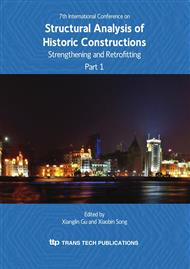p.125
p.131
p.137
p.143
p.149
p.155
p.163
p.169
p.175
A Case Study of the Korean Traditional Wood House-Mindori
Abstract:
The purpose of this study is to show logical member models considering the Korean traditional construction method and present a simple but rational modeling method of the whole structure to evaluate the structural stability of the KTWS. For this purpose, one of the KTWS, the Mindori House is selected and a structure analysis is performed considering its construction stage and load transfer mechanism. The variation of the behaviors according to joint modeling methods is studied using SAP2000 program and its results are compared with those of manual calculation.
Info:
Periodical:
Pages:
149-154
Citation:
Online since:
October 2010
Authors:
Price:
Сopyright:
© 2010 Trans Tech Publications Ltd. All Rights Reserved
Share:
Citation:


